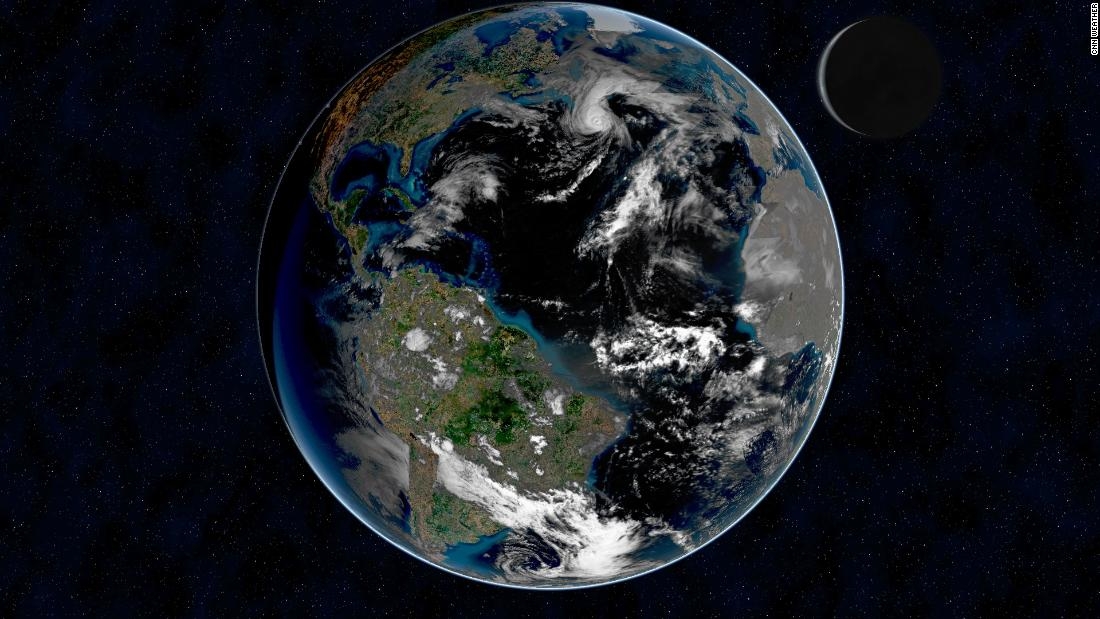(CNN) – For researchers who have been studying the universe for the past two decades, a new discovery far removed from this world is a new reality.
Researchers have found that the Earth is not as bright as it used to be and that it has become significantly darker in recent years.
Using a telescope that is no different than a telescope at home, researchers at the Big Bear Solar Laboratory have been taking measurements every night for the past 20 years to study the sun’s rotation and cloud cover.
They did this by measuring the “gray light”, which “captures the dark side of the moon and captures the reflected light of the earth and returns that light”, According to NASA. The amount of landscape brightness varies from night to night and from season to season.
Gray light or terrestrial light is a phenomenon that occurs when sunlight is reflected from the earth on the dark side of the moon. The moon reflects a small portion of that light back to the earth. An observer on Earth sees this as the dim light of the dark side of the moon. The best time to see this in the Northern Hemisphere is around the new moon in the spring months.
“If you look at the waning moon, you can see the full moon because three-quarters of it glows with this ghostly light,” explains Philip Goode, a researcher at the New Jersey Institute of Technology and its lead author. New study.
Twenty years after measuring the “ghost light”, they discovered that it was fading.
“It really reflects sunlight from the earth, and that’s what fades,” Goode said.
In fact, the Earth now emits less than half a watt of light per square meter than it did 20 years ago, which is equivalent to 0.5% less than the Earth’s reflection. The earth reflects 30% of the sunlight.
“In many of these things, you can set aside your general knowledge and have a lot of surprises,” Goode said. “This is one of those surprises.”
For the first 17 years, the data appeared to be almost identical, with researchers almost halting the rest of the study.
“We weren’t so excited about doing the data for the last three years because they didn’t seem to change for 17 years, but we decided to do it because we promised 20 years of data, so we did it, and we got the unexpected,” Goode said.
In one surprising case, the last three years of his study showed that the gray light had decreased dramatically. They thought their data was incorrect.

This map shows the average annual brightness or gray light of the Earth from 1998 to 2017 in black. The blue line shows CERES ‘annual albedo, another annual measure of the Earth’s reflection, from 2001 to 2019. Black lines and dashed blue lines are the best matching lines to show that the Earth’s reflection has decreased over the last 20 years. Credit: Goode et al. (2021), Geophysical Research Letters
“When we looked at the data for the last three years, it looked different,” Goode said. “The reaction was diminished and noticeable. So we thought we did something wrong. So we repeated it several times and it turned out to be perfect.”
They realized that the data did not correlate with the difference in the brightness of the sun due to the rotations of the sun, which meant that there must be something else.
What they noticed was less cloud cover. Sunlight jumps from the top of the cloud and reflects back into space. As the clouds subside, more sunlight enters.
“The Earth receives more heat because the reflected light is reduced, so more sunlight enters the visible spectrum,” Goode explains.
The western coasts of North and South America have seen the greatest decline in cloud cover, while sea surface temperatures have risen due to the reversal of climate. Pacific Decade Fluctuation (PDO).

This diagram shows the hot (red) and cold (blue) phases of the Pacific Decade Oscillation (PDO). Earth is currently in the cold state of PDO.
PDO is a term used to describe long-term temperature fluctuations in the Pacific Ocean. The warming and cooling of the oceans at different locations has a direct impact on the path of the jet stream. This jet stream change has a direct impact on long-term weather and climate conditions, especially along the west coast of North and South America.
“On the west coast of the American continent, low clouds were consumed and more sunlight entered, so we recorded a decrease in the Earth’s reflection,” Goode said.
Coote concludes that this has a direct impact on the Earth’s rapid warming. “Of course the earth gets more than half a watt per square meter, but it would be a guess to say what the earth decides to do with this energy.”


:quality(85)/cloudfront-us-east-1.images.arcpublishing.com/infobae/SMPW7M5BQFERBOQUPJXKCOKARY.jpg)
:quality(85)/cloudfront-us-east-1.images.arcpublishing.com/infobae/NP5NEZXMZFGNLBHNEQJHPJVMKM.jpg)

:quality(85)/cloudfront-us-east-1.images.arcpublishing.com/infobae/X7DZAL3I4REJTKPZ4Y4DYBHFMI.jpg)